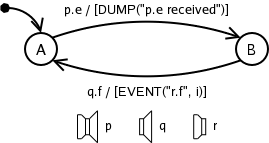
|
An example of ports is shown in Figure 4.13. There are three ports: p, q and r. A port is graphically represented as a box with one or two openings. Its name is placed beside the icon. There are different graphical representations for different types of ports. In this example, p is an inout-port, q is an in-port, and r is an out-port. (The direction of a port icon does not matter. Different types of ports have different icons.)
Once a port is defined, transitions in the model can refer to it by name. For example, the transition from A to B reacts to event p.e, where p is the name of a port, and e is the name of a message coming from that port. The other transition from B to A reacts to event q.f. In its actions, event r.f is output with parameter i. As described in the abstract syntax, an event generated by the model with a dot is considered as an out-going message. As a result, message f will be sent asynchronously via port r with parameter i.